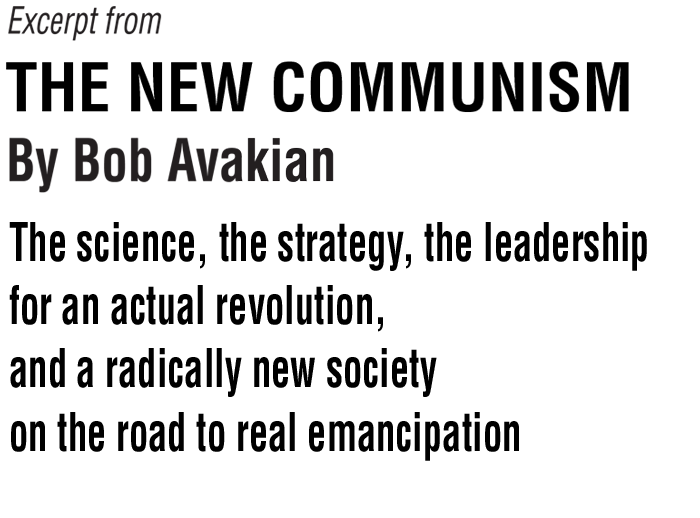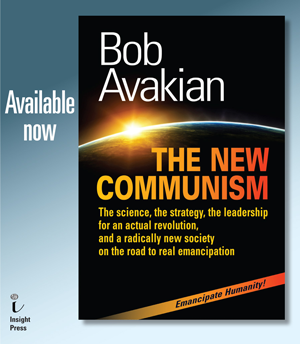
Editors' note: The following is an excerpt from the new work by Bob Avakian, THE NEW COMMUNISM. In addition to excerpts already posted on revcom.us, we will be running further excerpts from time to time on both revcom.us and in Revolution newspaper. These excerpts should serve as encouragement and inspiration for people to get into the work as a whole, which is available as a book from Insight Press. A prepublication copy is available on line at revcom.us.
This excerpt comes from the section titled "II. Socialism and the Advance to Communism: A Radically Different Way the World Could Be, A Road to Real Emancipation."
Excerpt 2 from the section:
The Constitution for the New Socialist Republic in North America—Solid Core with a Lot of Elasticity on the Basis of the Solid Core
We should be popularizing this in a very bold way. People often raise the criticism to us: “You always say what you’re against—you’re very negative, you’re against this, you’re against that, you always say what you’re against—but you don’t say what you’re for.” Well, yes, we do—and guess what, it’s not the Democratic Party! But here’s what we’re for—right here, right in this Constitution. A lot of grappling with contradictions went into this Constitution. As I said, it wasn’t just: “Let’s come up with things that will appeal to this group, and things that will appeal to that group.” That’s not how we proceeded at all. It was a matter of doing the best possible—it was dealing in the best possible way with the contradictions that could be anticipated, and what are the principles and guidelines that should be followed to deal with these contradictions. And some of it is very detailed and very precise. People should grapple with, and people should utilize, this document in that kind of way, with that kind of understanding.
Or let’s take another contradiction: Why is the possibility of a draft, for the armed forces of the New Socialist Republic, included in this Constitution? Why doesn’t it say that you can just rely on people volunteering? Well, it does make the point that people volunteering is the main aspect—the main thing that should be relied on—winning people politically and ideologically. In a discussion I had with someone who grew up in China, they said that when China was a socialist country, people in China—the youth in particular—were just tremendously inspired to join the People’s Liberation Army, to defend the socialist state and back up the revolution in the world. People wanted to do this, they wanted to be defenders of the revolution. So there is a lot of that sentiment and orientation that can be relied on. On the other hand, there’s a relation between necessity and freedom here, that you’re going to be dealing with. Why does it say, in this Constitution, that you can’t teach creationism in the schools, that the science of evolution is going to be taught as a fact? Why not just leave it up to people to decide, why not see if anybody likes creationism and wants it taught in the schools? No! You have to set certain terms—this point has been repeatedly emphasized, and for good reason—you have to set certain terms. That’s the solid core you set—and you actually create necessity for other forces by setting certain terms. And then you struggle things out on that basis. This point has been illustrated by using the example of the movie, from a few years ago, Remember the Titans. In the situation that movie was dealing with, in a city in the South several decades ago, they integrated the schools there, they integrated the football team in what had been essentially an all-white school, and they even replaced the previous white coach with a Black football coach. And then they said: Now, let’s deal with the struggle that has to be waged around this. They didn’t go to all the white people and say: “Do you want to integrate the school and integrate the football team and, on top of it, have a Black coach for the football team?” Guess what they would have said?
There are all kinds of things like that in this Constitution. Why does it talk about socializing ownership of the means of production? Why not just leave it to people to vote how they want the economy to run? Because you have to have a solid core, certain fundamental principles, and you have to set terms and create certain necessity. And we aren’t yet at the point—and we won’t be at the beginning stage that this Constitution is talking about—where you can rely solely on people volunteering for the armed forces if the very existence of your republic is in danger. There’s a certain necessity you put on people. Now, if you rely on that, then you’re on a slippery slope toward becoming like a bourgeois state, and you’re exercising power more and more in that way. But, put it this way: There is a certain value and importance, when you have the freedom to do so, to set certain necessity, to set certain terms, and then struggle things out from that standpoint.
Contents
Publisher's Note
Introduction and Orientation
Foolish Victims of Deceit, and Self-Deceit
Part I. Method and Approach, Communism as a Science
Materialism vs. Idealism
Dialectical Materialism
Through Which Mode of Production
The Basic Contradictions and Dynamics of Capitalism
The New Synthesis of Communism
The Basis for Revolution
Epistemology and Morality, Objective Truth and Relativist Nonsense
Self and a “Consumerist” Approach to Ideas
What Is Your Life Going to Be About?—Raising People’s Sights
Part II. Socialism and the Advance to Communism:
A Radically Different Way the World Could Be, A Road to Real Emancipation
The “4 Alls”
Beyond the Narrow Horizon of Bourgeois Right
Socialism as an Economic System and a Political System—And a Transition to Communism
Internationalism
Abundance, Revolution, and the Advance to Communism—A Dialectical Materialist Understanding
The Importance of the “Parachute Point”—Even Now, and Even More With An Actual Revolution
The Constitution for the New Socialist Republic in North America—
Solid Core with a Lot of Elasticity on the Basis of the Solid Core
Emancipators of Humanity
Part III. The Strategic Approach to An Actual Revolution
One Overall Strategic Approach
Hastening While Awaiting
Forces For Revolution
Separation of the Communist Movement from the Labor Movement, Driving Forces for Revolution
National Liberation and Proletarian Revolution
The Strategic Importance of the Struggle for the Emancipation of Women
The United Front under the Leadership of the Proletariat
Youth, Students and the Intelligentsia
Struggling Against Petit Bourgeois Modes of Thinking, While Maintaining the Correct Strategic Orientation
The “Two Maximizings”
The “5 Stops”
The Two Mainstays
Returning to "On the Possibility of Revolution"
Internationalism—Revolutionary Defeatism
Internationalism and an International Dimension
Internationalism—Bringing Forward Another Way
Popularizing the Strategy
Fundamental Orientation
Part IV. The Leadership We Need
The Decisive Role of Leadership
A Leading Core of Intellectuals—and the Contradictions Bound Up with This
Another Kind of “Pyramid”
The Cultural Revolution Within the RCP
The Need for Communists to Be Communists
A Fundamentally Antagonistic Relation—and the Crucial Implications of That
Strengthening the Party—Qualitatively as well as Quantitatively
Forms of Revolutionary Organization, and the “Ohio”
Statesmen, and Strategic Commanders
Methods of Leadership, the Science and the “Art” of Leadership
Working Back from “On the Possibility”—
Another Application of “Solid Core with a Lot of Elasticity on the Basis of the Solid Core”
Appendix 1:
The New Synthesis of Communism:
Fundamental Orientation, Method and Approach,
and Core Elements—An Outline
by Bob Avakian
Appendix 2:
Framework and Guidelines for Study and Discussion
Notes
Selected List of Works Cited
About the Author
 Download PDF of entire work
Download PDF of entire work